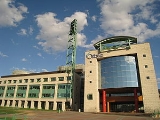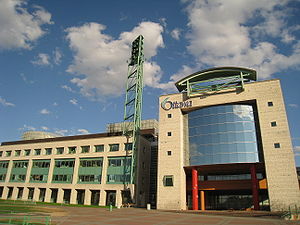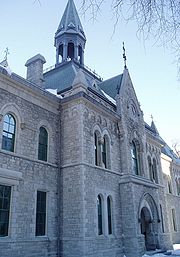
Ottawa City Hall
Encyclopedia

Ottawa
Ottawa is the capital of Canada, the second largest city in the Province of Ontario, and the fourth largest city in the country. The city is located on the south bank of the Ottawa River in the eastern portion of Southern Ontario...
, Canada
Canada
Canada is a North American country consisting of ten provinces and three territories. Located in the northern part of the continent, it extends from the Atlantic Ocean in the east to the Pacific Ocean in the west, and northward into the Arctic Ocean...
. The downtown complex consists of two connected buildings: a modern wing located on Laurier Avenue and a 19th century heritage wing located on Elgin Street
Elgin Street (Ottawa)
Elgin Street is a street in the Golden Triangle of Ottawa, Ontario, Canada. Originally named Biddy's Lane, it was later named after Lord Elgin....
. Although City Hall has frontage on two major streets, the main entrance is on Laurier Avenue, and the municipal address is 110 Laurier Avenue West.
Main building
The modern wing, which serves as the main section of City Hall, was built in 1990 as the headquarters of the former Regional Municipality of Ottawa-CarletonRegional Municipality of Ottawa-Carleton
The Regional Municipality of Ottawa–Carleton was a regional government area and census division in Ontario, Canada which existed from 1969 until 2001...
, and is located between the Cartier Square Drill Hall
Cartier Square Drill Hall
The Drill Hall at Cartier Square is a dedicated military training facility in Ottawa, Ontario, Canada. It has been a local landmark since its construction in 1879. The drill hall is long and has two tall mansard towers....
and the Ottawa Court House. This section of City Hall contains the Council chamber (known as Andrew Haydon
Andrew S. Haydon
Andrew Scott "Andy" Haydon is a Canadian engineer and politician. He was reeve of Nepean Township, Ontario from 1970 to 1978 and Regional Chair of Ottawa-Carleton from 1978-1991...
Hall), a large atrium and a number of offices and public services. The front of the building is marked by a large open plaza that faces Confederation Park
Confederation Park
Confederation Park is a park in downtown Ottawa and a National Historic Site of Canada. It is bordered on the south by Laurier Avenue and Ottawa City Hall; on the east by the Rideau Canal; on the north by the Mackenzie King Bridge, the Rideau Centre and the National Arts Centre; and, to the west,...
across Laurier Avenue. The plaza is home to concerts, festivals, and other community events. The grounds have a number of sculpture
Sculpture
Sculpture is three-dimensional artwork created by shaping or combining hard materials—typically stone such as marble—or metal, glass, or wood. Softer materials can also be used, such as clay, textiles, plastics, polymers and softer metals...
s, including a sound sculpture
Sound sculpture
Sound sculpture is an intermedia and time based art form in which sculpture or any kind of art object produces sound, or the reverse...
, and also a fountain
Fountain
A fountain is a piece of architecture which pours water into a basin or jets it into the air either to supply drinking water or for decorative or dramatic effect....
.
The site had originally been the parade ground for the Drill Hall. During the Second World War, a complex of structures was erected to house military staff. These buildings were meant to be temporary, but they remained in place for several decades. They were eventually demolished and the City Hall and courthouse were built on the site. The Regional Headquarters building was chosen as the new City Hall upon the amalgamation of the Region and its constituent municipalities in 2001, largely due to its central location. The architecturally acclaimed John G. Diefenbaker Building, located to the east of downtown, was subsequently sold to the federal government.
Heritage Building

Ottawa Normal School
The Heritage Building is today part of Ottawa City Hall. It was originally built in 1874 as Ottawa Normal School and served as a teacher's college. The Gothic Revival building stands at Elgin Street and Lisgar and several extensions were added to the rear of the building.It was part of Ontario's...
, built in 1875, and which now serves as the "Heritage Building" section of City Hall. Connected to the modern wing, the Heritage Building contains the offices of the Mayor and members of Council (the mayor's office overlooks Elgin Street), as well as a number of offices and committee rooms (including one committee room located in the former gymnasium of the Normal School).
The Heritage Building was designated a National Historic Site of Canada in 1974.
See also
The current building is only one of several structures that have served as Ottawa's city hall:
- 1849-1877: The First City HallFirst City Hall (Ottawa)The first city hall for the city of Ottawa, Ontario was built in 1849 on Elgin Street between Queen and Albert Streets.Originally known as the West Ward Market Building on Elgin Street, the building was one of two markets in Ottawa, then called Bytown...
was a converted market at Queen and Albert Streets, donated by Nicholas SparksNicholas Sparks (politician)Nicholas Sparks was an early landholder of Ottawa, Canada who owned most of the lands in the present day commercial core of Downtown Ottawa.Sparks was born in Darrah parish, County Wexford in Ireland and came to Canada in 1816... - 1877-1931: The Second City HallSecond City Hall (Ottawa)Ottawa, Ontario's second city hall was built in 1877 on Elgin Street between Queen and Albert Streets and next to Ottawa's First City Hall.Built by architects Horsey and Sheard of Ottawa, the Second Empire French and Italian Style had one tall tower and three smaller ones...
, a more modern sturdy stone structure, was built next to the first site, it was destroyed by fire in 1931 - 1931-1958: The Transportation BuildingTransportation Building (Ottawa)The Transportation Building in Ottawa, Canada is a historic Gothic revival/Chicago school office tower. The building stands at the intersection of Sussex Drive and Rideau Street. It was built by C. Jackson Booth, son of lumber baron J.R. Booth in 1916. It was across the street from Union...
served an extended period as Ottawa's temporary city hall - 1958-2000: What is now known as the John G. Diefenbaker Building on Green IslandGreen Island (Rideau River)Green Island in Ottawa, Ontario, Canada, is an island at the end of the Rideau River, at the Rideau Falls at the confluence with the Ottawa River. It is situated in the neighbourhood of New Edinburgh....
opened in 1958 and was heavily expanded in the late 1990s.

